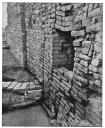 Civilization arose in India a very long time ago. Like other early civilizations, it began along rivers. Discover more about these ancient Asian people.
Civilization arose in India a very long time ago. Like other early civilizations, it began along rivers. Discover more about these ancient Asian people.
The Harappan Disappearance: A Mystery of Ancient India
As with the civilizations in Egypt, China, and the Fertile Crescent, the Indus River people depended on the river for their daily needs. They farmed in the rich soil that the river dumped on its banks. They traded along the river with other ancient neighbors. These people were unique, though. They had advanced farther on the civilization scale than any of their ancient counterparts.
Scholars do not know who the leaders of this first great civilization were, but they do believe that the leaders may have had twin capitals—at Harappa and at Mohenjo-daro, the former on the Indus itself and the latter 400 miles away on the Ravi River, a tributary of the great Indus. Archaeological remains uncovered at these two great city sites suggest that the Harrappan civilization, as it is commonly known, was a great one indeed.
 At each site, a citadel atop a high mound dominates the city landscape and offers protection for the city proper below. The people stored grain in large warehouses in preparation for a famine. They developed a system of weights and measures to facilitate trade with other cultures, mainly Mesopotamia. They were the first people in the world to grow cotton and fashion it into dyed cotton cloth. They dug ditches and canals to irrigate their farms. They had their own system of writing that has yet to be deciphered. They used a common currency.
At each site, a citadel atop a high mound dominates the city landscape and offers protection for the city proper below. The people stored grain in large warehouses in preparation for a famine. They developed a system of weights and measures to facilitate trade with other cultures, mainly Mesopotamia. They were the first people in the world to grow cotton and fashion it into dyed cotton cloth. They dug ditches and canals to irrigate their farms. They had their own system of writing that has yet to be deciphered. They used a common currency.
Most striking of all is their civil engineering. They planned the patterns of their cities, laying out streets in rectangular patterns and including drainage systems that led to brick-lined sewers. They lived in brick buildings, some two and three stories high. In almost every respect, they were an advanced people. Yet, by 1700 B.C., the Harappan Civilization had disappeared.

 Mohenjodaro, Larkana District, Sindh, Pakistan
Mohenjodaro, Larkana District, Sindh, Pakistan
 Indus Valley Street with Covered Drain, Mohenjo-daro, Sindh
Indus Valley Street with Covered Drain, Mohenjo-daro, Sindh
 |
The Ravi Phase denotes a newly discovered early phase of Indus culture (c. 3300-2800 BC, see the Timeline.)

The origins of Indus writing can now be traced to the Ravi Phase (c. 3300-2800 BC) at Harappa. Some inscriptions were made on the bottom of the pottery before firing. Other inscriptions such as this one were made after firing. This inscription (c. 3300 BC) appears to be three plant symbols arranged to appear almost anthropomorphic. The trident looking projections on these symbols seem to set the foundation for later symbols such as those seen in 131.

| 153. "Granary area" | ||
Limited excavations in the granary area at Harappa starting in 1997 (Trench 41 area) and 1999 have begun a new examination of this important building, first excavated in the 1920s. Although referred to as a granary, this characterization by earlier archaeologists of similar large structures at Mohenjo-daro and Harappa is not borne out by any compelling evidence such as grain deposits. The structure, the largest known from a Harappan site, could have served any number of other functions. 
| ||


